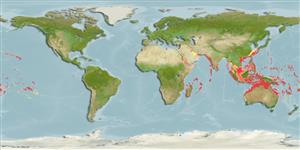Environment: milieu / climate zone / depth range / distribution range
экология
морской; солоноватоводный ассоциированный с рифами; пределы глубины 0 - 150 m (Ref. 30573), usually 10 - 137 m (Ref. 27115). Tropical; 25°C - 28°C (Ref. 27115); 31°N - 32°S, 30°E - 122°W (Ref. 57251)
Indo-Pacific: Red Sea and East Africa (Ref. 9710), including the Mascarene Islands (Ref. 37792) to the Hawaiian, Marquesas and Ducie islands, north to southern Japan, south to Lord Howe Island.
Length at first maturity / Size / Вес / Возраст
Maturity: Lm 45.0 range ? - ? cm
Max length : 75.0 cm FL самец/пол неопределен; (Ref. 1602); common length : 50.0 cm TL самец/пол неопределен; (Ref. 30573)
колючие лучи спинного плавника (общее число) : 6; членистые (мягкие) лучи спинного плавника (общее число) : 26 - 29; колючие лучи анального плавника: 2; членистые (мягкие) лучи анального плавника: 27 - 30. This species is distinguished by the following characters: body moderately deep and compressed, its depth 2.6 to 3.2 times in standard length (SL); dorsal profile of body uniformly convex, without any bony horn-like projection or protuberance anteriorly on head; mouth small; incisiform teeth very small, somewhat pointed, finely serrate on edges, as many as 80 in upper jaw and 100 in lower jaw of large adults; continuous unnotched D VI (rarely V or VII),26-29; A II,27-30; pectoral-fin rays 17-18 (usually 17); pelvic fins I,3; caudal fin slightly emarginate in young, becoming truncate in adults; caudal peduncle slender, subcylindrical, with a pair of bony plates on each side that develop large sharp antrorse keels with age; body colour dark brownish grey, shading ventrally to yellowish (life colour may vary from dark brown to light blue-grey); edge of operculum and preopercle usually dark brown; dorsal and anal fins yellowish with faint diagonal brown bands and a blue margin; tongue black at lengths of 25 cm or more (Ref. 9808).
Inhabits clear lagoon and seaward reef slopes (Ref. 9710, 48637). Benthopelagic (Ref. 58302). Usually seen in large schools (Ref. 90102). Mainly diurnal, it feeds on zooplankton such as crab larvae, arrow worms, pelagic tunicates, and occasionally filamentous red algae. The species is never poisonous (Ref. 4795). Minimum depth reported taken from Ref. 128797.
Life cycle and mating behavior
Maturities | размножение | Spawnings | Egg(s) | Fecundities | личинки
Spawn in pairs (Ref. 240).
Myers, R.F., 1991. Micronesian reef fishes. Second Ed. Coral Graphics, Barrigada, Guam. 298 p. (Ref. 1602)
Статус Красного Списка МСОП (Ref. 130435)
Использование человеком
рыболовство: коммерческий; объект спортивного рыболовства: да; аквариум: коммерческий
дополнительная информация
инструменты
Специальные отчеты
Скачать в формате XML
ресурсы в Интернет
Estimates based on models
Preferred temperature (Ref.
123201): 22.1 - 28.9, mean 27.5 °C (based on 2224 cells).
Phylogenetic diversity index (Ref.
82804): PD
50 = 0.5000 [Uniqueness, from 0.5 = low to 2.0 = high].
Bayesian length-weight: a=0.02188 (0.01362 - 0.03514), b=2.99 (2.85 - 3.13), in cm total length, based on LWR estimates for this species & Genus-body shape (Ref.
93245).
Trophic level (Ref.
69278): 3.1 ±0.33 se; based on food items.
Generation time: 5.0 ( na - na) years. Estimated as median ln(3)/K based on 1
growth studies.
устойчивость к внешним воздействиям (Ref.
120179): низкий, минимальное время удвоения популяции 4.5-14 лет (tm=7; K=0.221; Tmax=44;).
Fishing Vulnerability (Ref.
59153): Moderate vulnerability (42 of 100).
Nutrients (Ref.
124155): Calcium = 26.9 [15.5, 50.5] mg/100g; Iron = 0.53 [0.26, 0.94] mg/100g; Protein = 19.1 [18.0, 20.1] %; Omega3 = 0.152 [0.094, 0.288] g/100g; Selenium = 43 [22, 76] μg/100g; VitaminA = 73 [25, 209] μg/100g; Zinc = 1.14 [0.78, 1.63] mg/100g (wet weight);
